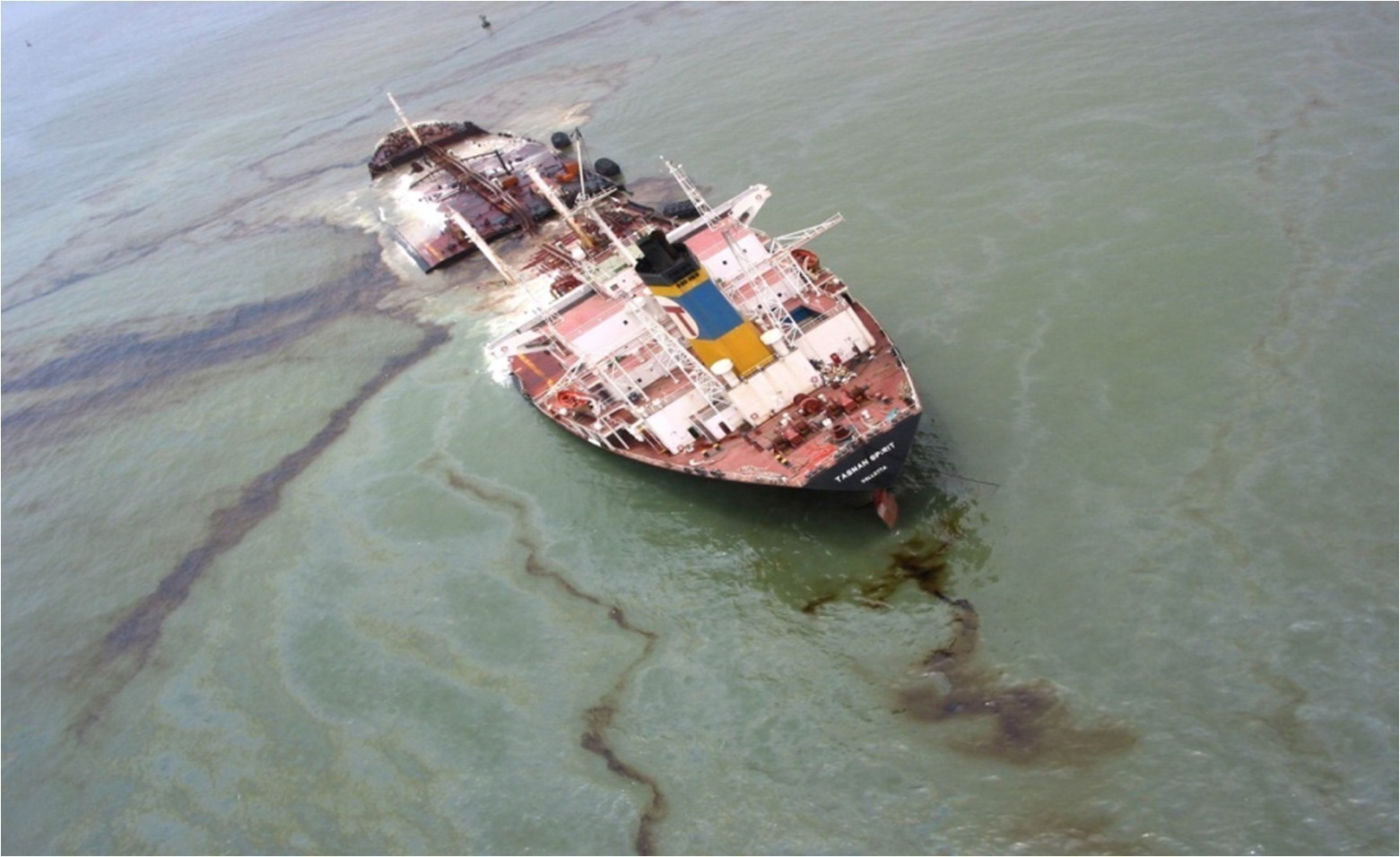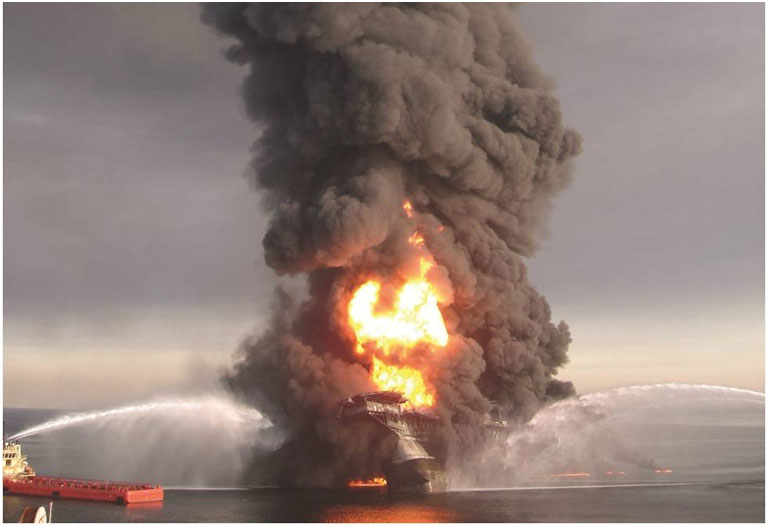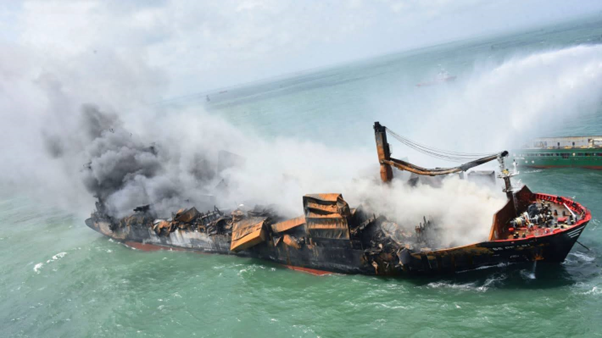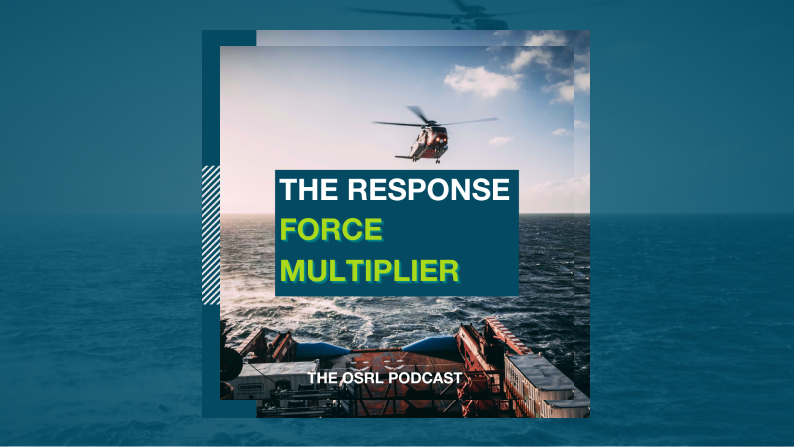Introduction
The MV Tasman Spirit, a single-hulled tanker carrying 67,535 tonnes of Iranian Light Crude destined for the Pakistan National Shipping Corporation (PNSC), ran aground near Karachi port on 27 July 2003.
Three attempts were made to tow it away but all failed. Cracks appeared in the hull on 14 August. The oil spill impacted 14 km of coastline along the Clifton Beach, Karachi, leading to a spill of approximately 27,000 metric tons of oil. The evaporated component of the oil released VOCs (Volatile Organic Compounds) and the oil reached the shoreline. OSRL assisted in containment and deflection booming, dispersant spraying, skimming operations and shoreline clean-up.
Incident Timeline
27 July: 1335 hrs
The oil tanker Tasman Spirit runs aground in the access channel for the port of Karachi. She is carrying 67,535 tonnes of Iranian Light crude oil for delivery to the Pakistan Refinery Limited (PRL).
13 August
MV Tasman Spirit starts to break -up and significant quantities of oil are spilled. Lightering operations allows 13, 000 tonnes to be recovered.
15 - 17 August
Aerial spraying starts.
18 August
Approximately 27,000 tonnes of oil has been lost.
22 August
Further structural collapse occurs leading to a loss of between 100 to 200 tonnes.
29 August and 4 September
Further releases of oil are reported.


OSRL Mobilisation
OSRL were activated by ITOPF under a Third Party Agreement. The responders faced many challenges including:
- an excessive amount of debris in the port impeding oil recovery
- a lack of suitable vessels for offshore recovery
- boat drivers unfamiliar in towing of booms
- high current speeds
- a lack of waste disposal routes
- different beaches controlled by different authorities
- local workers unfamiliar with the use of PPE
- a lack of hygienic welfare facilities for the OSRL responders resulting in illness and subsequent lost work days.

Personnel and Equipment
The first response measures consisted of the use of containment equipment and the application of dispersants from tug boats.
The situation worsened and equipment from OSRL was mobilised. A dispersant spraying Hercules, based in Singapore, was sent to site, based on advice from ITOPF (International Tanker Owners Pollution Federation).
On 18 August, 25,000 tonnes in total of hydrocarbons had been recovered from the vessel’s tanks, which still contained an estimated 14,000 tonnes. Additional containment booms were deployed around the wreck and boats fitted with dispersant spray equipment worked on the contained product.
Aerial spraying, implemented from 15 to 17 August, noticeably reduced the quantity of hydrocarbons visible on the surface of the water. In total, 16 tonnes of dispersants were sprayed on the oil slicks. The aircraft stayed on stand-by and vessel spraying went on throughout the response.
Onshore, pollution reached Clifton Beach, next to Karachi, with an estimated volume of 300 m³, covering some 6 km. Some areas around the harbour and some mangrove swamps were also affected. Oleophilic disc skimmers were used on the harbour shoreline for the cleaning operations, while on the coastline, recovery was carried out manually.

Response Summary
On 27 July 2003, the oil tanker MV Tasman Spirit, loaded with 67,000 tonnes of Iranian Light Crude, grounded in the access channel to Karachi harbour. The hull was perforated and around 27,000 tonnes of crude was spilt. Lightering operations on 13 August allowed 13,000 tonnes of oil to be recovered, after which, bad weather hindered operations and caused the vessel to split in two.
Given the low persistence of Iranian Light Crude oil and the high mixing energy in the many damaged vessel cargo tanks generated by the heavy swell, it is likely that most of the spilt oil dispersed naturally. Field surveys conducted showed little or no impact on mangroves, salt pans and other sensitive resources in the vicinity. The geographical extent of shoreline oiling was limited to a 10 mile radius around the grounded tanker.

Responder Reflections: Jamaluddin bin Jaafar
"It was my first time in Pakistan, and this response was one of the first responses attended by OSRL and EARL under the global alliance.
We had to operate from a military airport for dispersant operations, so we obviously had restricted access. Intuitively, we made ‘friends’ with people, and observed who can help get things done, and who has the authority to provide resources, like providing a forklift for loading and unloading of equipment and having a supply of reliable workers for manual labour.
Communication was a major challenge. We had to set clear rules for safety and behaviour, and arrived at a common understanding with the local labourers that they should stop work if they were feeling unwell, or had taken alcohol or drugs; we also had to help resolve any misunderstanding between workers so that the work can proceed without disruption.
One of the challenges during the response was to convince people to use PPE. The brand new safety shoes issued to the local labourers were not worn, but instead, put up for sale at the weekend market!
I was responsible for shoreline clean-up at a section of a recreational beach, and supervised about 50 workers. I had to first observe the natural setting of the beach, and made an interesting observation that crabs were still burrowing holes, thus renewing the surface layer of the sand and burying the oil – the surface clean-up had to be done much more quickly!
Stakeholders were briefed daily at the end of the work shift, and there had to be obvious progress. Something as simple as the number of bags of waste collected everyday provided a visible difference and helped to keep the motivation and momentum during a prolonged response.
I left after a 3-week rotation, while other colleagues continued with the work until we were demobilised a few months later."
We've got you covered!
Wherever in the supply chain your oil spill risks lie, we are ready to respond with our expertise and resources anytime, anywhere with our Member Response services.







